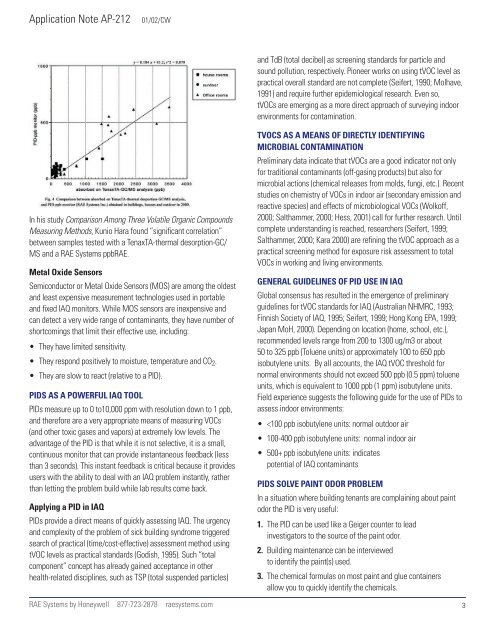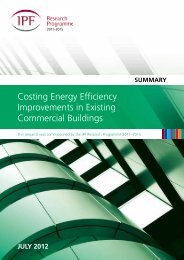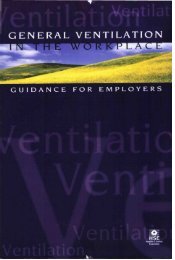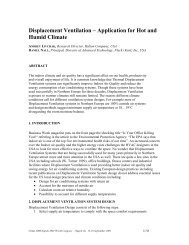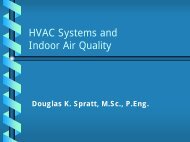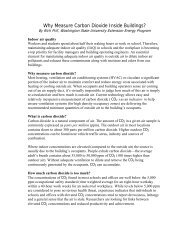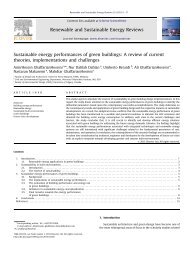Using PIDs for Indoor Air Quality (IAQ) surveys
Using PIDs for Indoor Air Quality (IAQ) surveys
Using PIDs for Indoor Air Quality (IAQ) surveys
You also want an ePaper? Increase the reach of your titles
YUMPU automatically turns print PDFs into web optimized ePapers that Google loves.
Application Note AP-21201/02/CWand TdB (total decibel) as screening standards <strong>for</strong> particle andsound pollution, respectively. Pioneer works on using tVOC level aspractical overall standard are not complete (Seifert, 1990; Molhave,1991) and require further epidemiological research. Even so,tVOCs are emerging as a more direct approach of surveying indoorenvironments <strong>for</strong> contamination.In his study Comparison Among Three Volatile Organic CompoundsMeasuring Methods, Kunio Hara found “significant correlation”between samples tested with a TenaxTA-thermal desorption-GC/MS and a RAE Systems ppbRAE.Metal Oxide SensorsSemiconductor or Metal Oxide Sensors (MOS) are among the oldestand least expensive measurement technologies used in portableand fixed <strong>IAQ</strong> monitors. While MOS sensors are inexpensive andcan detect a very wide range of contaminants, they have number ofshortcomings that limit their effective use, including:• They have limited sensitivity.• They respond positively to moisture, temperature and CO 2 .• They are slow to react (relative to a PID).PIDS AS A POWERFUL <strong>IAQ</strong> TOOL<strong>PIDs</strong> measure up to 0 to10,000 ppm with resolution down to 1 ppb,and there<strong>for</strong>e are a very appropriate means of measuring VOCs(and other toxic gases and vapors) at extremely low levels. Theadvantage of the PID is that while it is not selective, it is a small,continuous monitor that can provide instantaneous feedback (lessthan 3 seconds). This instant feedback is critical because it providesusers with the ability to deal with an <strong>IAQ</strong> problem instantly, ratherthan letting the problem build while lab results come back.Applying a PID in <strong>IAQ</strong><strong>PIDs</strong> provide a direct means of quickly assessing <strong>IAQ</strong>. The urgencyand complexity of the problem of sick building syndrome triggeredsearch of practical (time/cost-effective) assessment method usingtVOC levels as practical standards (Godish, 1995). Such “totalcomponent” concept has already gained acceptance in otherhealth-related disciplines, such as TSP (total suspended particles)TVOCS AS A MEANS OF DIRECTLY IDENTIFYINGMICROBIAL CONTAMINATIONPreliminary data indicate that tVOCs are a good indicator not only<strong>for</strong> traditional contaminants (off-gasing products) but also <strong>for</strong>microbial actions (chemical releases from molds, fungi, etc.). Recentstudies on chemistry of VOCs in indoor air (secondary emission andreactive species) and effects of microbiological VOCs (Wolkoff,2000; Salthammer, 2000; Hess, 2001) call <strong>for</strong> further research. Untilcomplete understanding is reached, researchers (Seifert, 1999;Salthammer, 2000; Kara 2000) are refining the tVOC approach as apractical screening method <strong>for</strong> exposure risk assessment to totalVOCs in working and living environments.GENERAL GUIDELINES OF PID USE IN <strong>IAQ</strong>Global consensus has resulted in the emergence of preliminaryguidelines <strong>for</strong> tVOC standards <strong>for</strong> <strong>IAQ</strong> (Australian NHMRC, 1993;Finnish Society of <strong>IAQ</strong>, 1995; Seifert, 1999; Hong Kong EPA, 1999;Japan MoH, 2000). Depending on location (home, school, etc.),recommended levels range from 200 to 1300 ug/m3 or about50 to 325 ppb (Toluene units) or approximately 100 to 650 ppbisobutylene units. By all accounts, the <strong>IAQ</strong> tVOC threshold <strong>for</strong>normal environments should not exceed 500 ppb (0.5 ppm) tolueneunits, which is equivalent to 1000 ppb (1 ppm) isobutylene units.Field experience suggests the following guide <strong>for</strong> the use of <strong>PIDs</strong> toassess indoor environments:•


